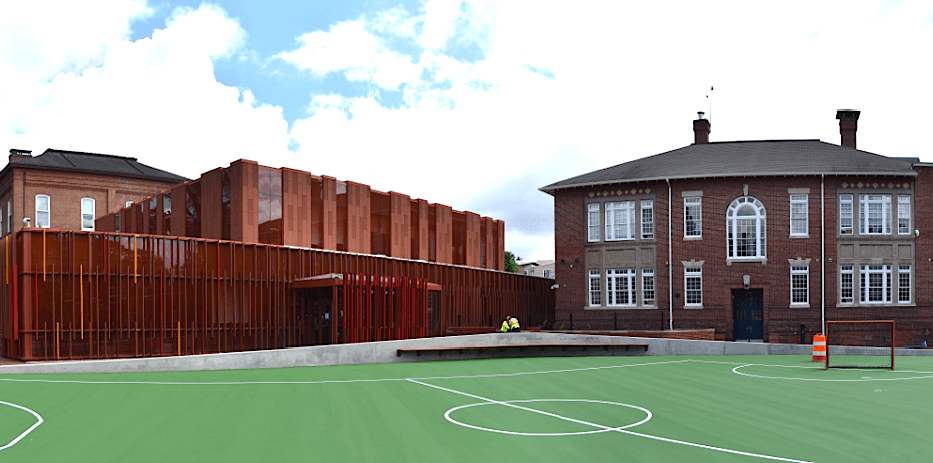Back to School (Sort of) in Georgetown
By • August 13, 2020 0 2100

As schools in D.C. and Georgetown grapple with being fully online, fully in-person or a mix this fall, we must ask: What is best for children, teachers and staff — along with economic and, most of all, public health?
“It’s 50-50,” a Hyde-Addison Elementary School teacher told The Georgetowner (off the record). “My colleagues, parents and students are split about how and when schools should go back to in-person or remain fully virtual.”
“So many parents, myself included, are really struggling with the risk/reward equation of in-person learning. Our kids have suffered from the isolation. So, we are desperate to get them back to some normalcy. But we also need to be honest about where we are in this pandemic,” Liz D’Angio, a Georgetown parent whose children attend Holy Trinity School, told The Georgetowner.
“I am agonizing for the single parents, the parents of children with special needs that require skilled interactions, the children in abusive homes and especially those in situations where there is no place to study and even little access to food,” said former Advisory Neighborhood Commissioner Monica Roaché, who lives on P Street and works for Arlington County Schools.
One size doesn’t fit all. Remote learning can be fine for some, even many. But not all. Health concerns related to the trends in COVID-19 cases and mortality rates differ by state, by region and even by ward in the District.
Coronavirus statistics are collected daily by the District Department of Health and the national Centers for Disease Control and Prevention. On Aug. 6, D.C. reported 12,443 cases and 587 deaths. Last week, COVID-19 mortality rate in D.C. was 4.7 percent, higher than the 3.7 national percentage and those of Maryland (3 percent) and Virginia (2 percent).
The risk of school children getting severely sick from the disease appears to be extremely low at this time. In the District, almost 1,000 individuals under the age of 19 have tested positive for the virus since March, but there have been no deaths. In contrast, 43 patients between the ages of 20 and 50 — the age range of most teachers — have died of virus complications to date.
“Rising caseloads in July didn’t result in a spike in hospitalizations or deaths,” said LaQuandra Nesbitt, director of the District Department of Health, on Aug. 5. “That might be the result of young people making up a growing proportion of new cases. What may be happening is that if younger populations are tending to be more impacted, their severity of illness may be less and death may be less likely in that age group.”
MAYOR BOWSER CHANGES HER MIND
Mayor Muriel Bowser unexpectedly announced on July 30 that all D.C. public schools would be operating online-only for the first term, running from Aug. 31 through Nov. 9. Throughout July, school officials were considering a mixed-option plan of in-person classes.“
The decision to go all-virtual was not based on any particular health metrics,” the mayor said. “There were lots of other considerations, but safety for school personnel and students was the overwhelming priority. We had to consider parental and student comfort and workforce and faculty issues.”
On July 28, public school teachers in Washington, D.C., placed body bags outside the DCPS offices to protest a possible partial return to the classroom. The American Federation of Teachers threatened “safety strikes” across the nation if schools opened in-person.
INDEPENDENT SCHOOLS LOOK AT OPTIONS
The mayor’s decision to keep public schools closed put pressure on the District’s many private, independent and public charter schools. Almost all have small class sizes, non-union teachers and their own regulations, which give them flexibility that the public schools lack. But they also have grave concerns about health and safety.
“We expect charter schools to follow the District guidelines and be all-virtual as well,” Bowser stated at her July 30 press conference.
As of Aug. 6, some had decided to close. “We have just announced that Maret School will deliver its academic program virtually beginning Sept. 8,” Head of School Marjo Talbott told The Georgetowner. “We will conduct small orientation meetings on campus for students and teachers to meet personally. And we will be watching the health metrics carefully. It could change even by October.”
Catholic elementary schools such as Holy Trinity are still in the process of making a decision. “We are sending out a parental survey and planning a town hall meeting next week to help make our decision,” said a spokesperson for pastor Rev. C. Kevin Gillespie, S.J. As of this week, it looks like grades 3 and under will attend school five days with the upper grades meeting two days and going virtual for now.
Parents are also turning to private tutoring. Small education businesses are thriving. “All my classes of between one and five students filled immediately,” said Chloe Kaplan, founder of Amore Learning.
D.C. UNIVERSITIES CHOOSE VIRTUAL FALL
Last month, Georgetown, George Washington and American Universities announced that they would offer almost all undergraduate and graduate courses online. Campuses and dorms would be closed to all but a few hundred special-needs and foreign students who couldn’t get home. Catholic University is allowing freshmen and some transfers on campus.
But, as private institutions, they will all charge annual tuition of more than $50,000 a year. Some students have threatened lawsuits in protest.
“Online classes should be fine,” said Eric Langenbacher, a professor in Georgetown University’s government department. “The university has provided us with training and access to equipment and apps to better transform our courses, interactive seminars and student counseling online. Most of my colleagues indicated they were uncomfortable to come to campus personally right now. And college undergraduate numbers may be down as well this year. Many of my son’s friends, who just graduated from high school in June, have decided to take this year off as a gap year.”

